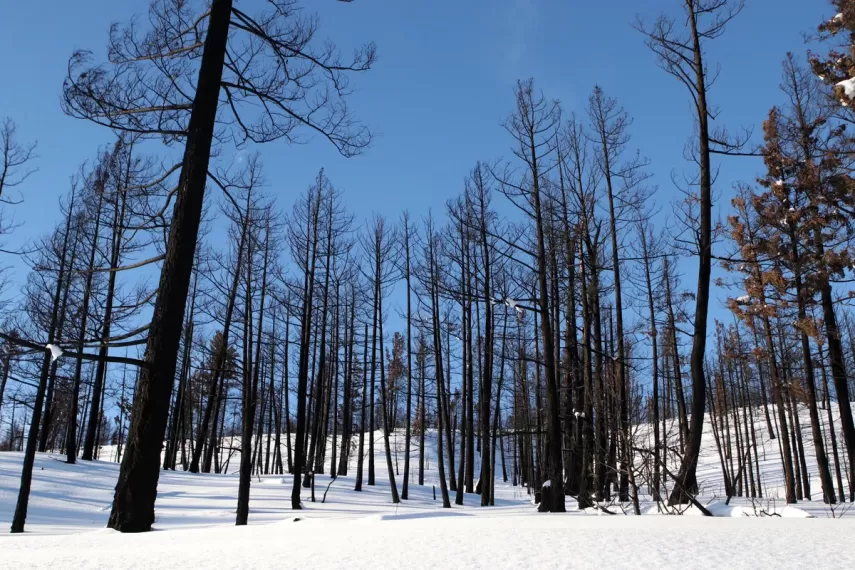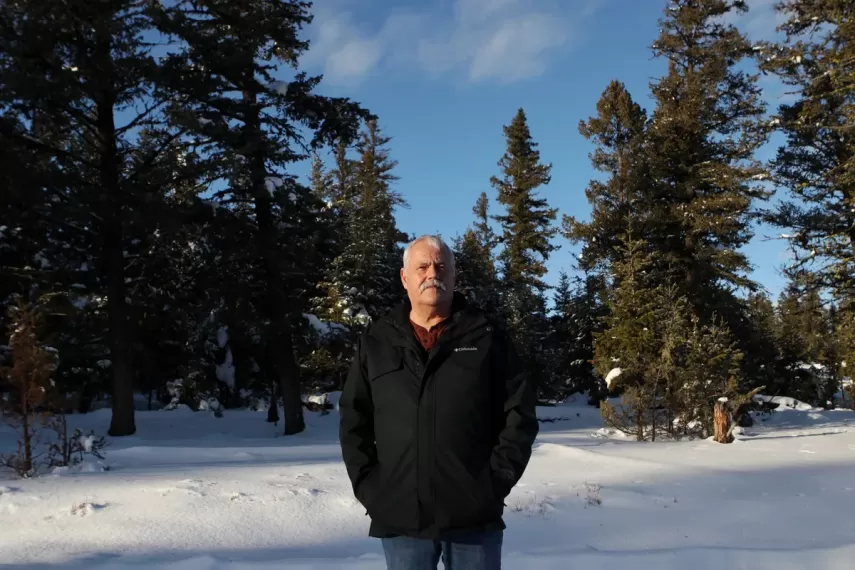
Logged trees are piled near the base of Elephant Hill in Ashcroft, B.C., on Jan. 10, 2022. Aaron Hemens / The Globe and Mail
By Wendy Stueck | January 17, 2022
Over the past two years, the Ashcroft Indian Band has been pressing the British Columbia government to overhaul the province’s forestry policies, saying the current system doesn’t reflect the government’s commitment to reconciliation with Indigenous peoples or its legal obligations to them.
Those efforts are spelled out in letters from the band to government officials – letters band administrator Jodene Blain has been sending with a growing sense of frustration.
“We are completely ignored,” Ms. Blain said. “We’ve had meetings and letters, but it’s gone nowhere.”

The Ashcroft band, based in the arid, rolling hills of B.C.’s Southern Interior, is seeking more say over forestry in its traditional territory and a bigger share of the proceeds. The effort is part of a province-wide push by First Nations to gain more influence over an industry that has shaped settlement and trade in B.C. for more than a century and remains a significant economic force.
According to the provincial government, the forestry sector accounted for about 43,000 jobs and about $11.5-billion in commodity exports in 2020 – about 29 per cent of B.C.’s total commodity exports that year. The sector contributed $5.6-billion to provincial GDP.
In theory, the stage is set for First Nations to assume a major role. Both B.C., in 2019, and the federal government, in 2020, passed legislation to implement the United Nations Declaration on the Rights of Indigenous People (UNDRIP), which sets out rights including that of Indigenous peoples to “own, use, develop and control” lands and resources they possess through traditional ownership, through occupation or through other means.
But the road to change has been bumpy. Forests are under pressure from wildfire and drought – threats many expect will become more severe as a result of climate change. Since August, 2020, more than 1,000 people have been arrested in a standoff over old-growth logging in Fairy Creek on Vancouver Island, even as the provincial government has rolled out measures to protect such forests under a review it launched in 2019.
Those measures include old-growth logging deferrals. The most recent batch was announced this past November. Industry groups have warned those deferrals, if implemented, could eliminate up to 18,000 jobs and force dozens of lumber mills to close. The provincial government has said the deferrals are designed to protect 2.6 million hectares of the most at-risk old-growth forests, the equivalent of about 6,400 Stanley Parks.
Some First Nations have endorsed the deferrals. Others have said they need more time to assess them than the 30-day period requested by the province, and that they need more say in how the changes are to be implemented.
In a December update, the Forests Ministry said 161 of the province’s 204 registered bands had responded to the deferrals, with the “vast majority” saying they wanted to engage on the topic but needed more time to make a decision.
The provincial government also passed a new forestry bill in November, saying the new legislation would allow government to reduce the timber harvesting rights of existing forest tenure holders, compensate them and then redistribute the timber harvesting rights to First Nations and other groups.
The First Nations Forestry Council (FNFC), an advocacy group focused on forest policy, has said the recent changes are at odds with reconciliation commitments and with B.C.’s Declaration on the Rights of Indigenous Peoples Act. The group has called for a “reset.”
“The province is making a giant misstep,” FNFC executive director Charlene Higgins said.
“We could be doing this in such a better way – collaboratively.”
B.C. Forests Minister Katrine Conroy was not available for an interview. In an e-mailed statement Sunday, she said: “Our government’s new vision for forest care is one where Indigenous peoples are full partners in sustainable forest management.”
Recent changes to forestry legislation were based on years of feedback from First Nations, including a forest strategy developed by the FNFC, the minister added. The FNFC has said the changes don’t take the strategy fully into account.
Ms. Conroy, however, said the legislative changes replace industry-developed stewardship plans with landscape plans that will better address ecological and cultural values, that include provisions for shared decision-making and that align with B.C.’s Declaration on the Rights of Indigenous Peoples Act. The province will also provide $12.7-million over three years to help First Nations develop old-growth policies, she said.

The Ashcroft band is part of the Nlaka’pamux Nation, a group of more than a dozen bands whose traditional territory spans the Fraser Canyon and the Southern Interior of B.C. and extends into the United States.
In 2017, the Elephant Hill wildfire swept through nearly 200,000 hectares in the region, destroying more than 100 homes, including about a dozen on the Ashcroft band’s main reserve.
The fire scorched the siding on Chief Greg Blain’s house. Mr. Blain, first elected as chief in 2004, said the band needs forestry revenues to finance projects such as its new, six-unit seniors’ residence. Completed last year, it’s now home to people who lost their homes in another wildfire – the one that destroyed the town of Lytton in June, 2021.
The Ashcroft band is small, with a registered population of 346 people, most of them living off-reserve.
In 2014, the band signed a Forest Consultation and Revenue Sharing Agreement, or FCRSA, through which it got a share of stumpage revenue from forestry operations on its territory. Stumpage is a fee that businesses or individuals pay when they harvest timber from Crown land in B.C.
The band was unsatisfied with the deal and did not renew it after a three-year term.

In a Jan. 3 letter to a provincial forests official, Mr. Blain said the band has, since 2016, been seeking a licence to harvest between 20,000 and 30,000 cubic metres of lumber a year from the Kamloops and Merritt Timber Supply Areas – designated areas of Crown land that the B.C. government uses to allot logging rights.
In 2021, the government set cutting limits of up to 1.2 million cubic metres for the Merritt TSA and 2.1 million cubic metres for Kamloops.
“We’re fighting for scraps,” Mr. Blain said. “Forestry is still happening, just not for us.”
FCRSAs are one of the main ways First Nations in B.C. get shares of revenue from forestry operations in their territories. The agreements provide for First Nations to receive percentages of stumpage revenue – typically, around 3 per cent to 6 per cent.
Launched in 2010, the FCRSA program has provided more than $541-million to nations throughout the province, according to a 2021 fact sheet released by the province. As of that update, 110 nations had agreements.
Dr. Higgins said FCRSAs are outdated because they don’t provide for joint decision-making, and because by signing, a First Nation essentially agrees to provincial forestry plans. Revenue-sharing from forestry operations should be 50 per cent, she said.
On Vancouver Island, the Tseshaht First Nation signed an FCRSA in 2011, but didn’t renew it after its three-year term.
“The percentage of revenue-sharing – some would argue that it is a slap in the face, considering we have never ceded or surrendered our territories,” said Ken Watts, chief councillor with the Tseshaht.
There are other programs that allow First Nations to tap into the forest economy, including First Nations Woodland Licenses, which are long-term forest tenures that are designed to give nations an increased role in forest management, including the ability to protect traditional uses.
Here, too, First Nations are bit players. As of early December, the province listed 22 First Nations Woodland Licenses that together accounted for just under 850,000 cubic metres of annual allowable cut – less than 2 per cent of the provincial total, Dr. Higgins said.
First Nations are entitled to receive economic benefits from their traditional territories, especially now that B.C. and Canada have embraced UNDRIP, said Harold Calla, a member of the Squamish Nation in B.C. and executive director of the First Nations Financial Management Board, a group that advises First Nations on tax and finance issues.
“More and more we are seeing the impacts of deforestation and why First Nations have been saying for many years you can’t allow unlimited logging,” Mr. Calla said in an e-mail.
“Forestry needs to transition to an economic model where it manages the forest as a sustainable resource. First Nations can provide some oversight on this transition.”
The Tsay Keh Dene Nation is based in northeastern B.C. in the Mackenzie Timber Supply Area. The supply area is the fourth largest in the province, spanning 6.4 million hectares, with an annual allowable cut of 4.5 million cubic metres.
Tsay Keh Dene is heavily engaged in forestry, with band-owned business ventures that include a logging contractor and an environmental consulting group. It has an FCRSA, signed in 2020, and several harvesting licences.
Those agreements, while welcome, don’t generate the revenue and benefits that Tsay Keh Dene believes it could attain if it had more control over land use, said Evan Mackinnon, the band’s manager of lands, resources and treaty operations.
So far, he has seen limited impact from B.C.’s UNDRIP legislation.
“What has changed is, there is more of a motivation to consult, and to consult meaningfully,” Mr. Mackinnon said.
But consultation is “inherently problematic,” he added.
“It is not joint decision-making. It is not providing a framework for self-governance and legitimate stewardship of the land.”

When announcing the province’s revised forestry legislation in October, Ms. Conroy told the B.C. legislature the new bill would “put government back in the driver’s seat of land-management decisions in partnership with First Nations.”
Past policies left too much control with the private sector and limited the province’s ability to fight climate change, protect old-growth forests, and share benefits with Indigenous and local communities, she said.
Some say the new policies don’t go far enough.
The Skeetchestn Indian Band came under an evacuation order in July, 2021, as a result of the Sparks Lake Fire near Kamloops. The flames ripped through just under 96,000 hectares, according to the B.C. Wildfire Service. Band members helped fight the fire, protecting homes, watersheds and livestock.
Mike Anderson, chief executive of Skeetchestn Natural Resources Corp., an economic development arm of the band, said the state of forests in Skeetchestn’s traditional territory is dire. More than half have been damaged by forest fires and an even larger chunk was clear-cut decades ago and replanted in a way that doesn’t match the biodiversity of what was harvested.
The band has an FCRSA, which Mr. Anderson described as a “take it or leave it” arrangement.
“All these arrangements are unilaterally arranged by the province. ‘We’re going to keep on logging, we’ve got your permission, now here’s what you get,’” he said.
Mr. Anderson would like Skeetchestn to have more control over land-use decisions. The band, he said, might decide it would make more economic and environmental sense to leave forests standing and sell carbon credits, rather than harvest lumber.
The provincial government’s revised legislation does not address revenue-sharing and does not make significant changes to the province’s process for deciding how much timber is available to be cut, Dr. Higgins said.
The province is “still focused on managing for timber first, and nations want that changed,” she added.
Managing forests for values other than timber would result in changes on the ground, said Mr. Blain, the Ashcroft chief.
“We know where the water is, where the creeks are, where the creeks have dried up,” he said. “For a lot of people now, it’s all about the money – how much value can you get out of this wood and sell as quick as you can.
“Whereas for us – we’ve been here a long time and we have different values.”
